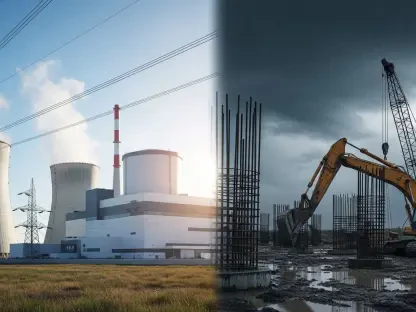In January 2025, President Donald J. Trump issued a series of executive orders that significantly altered the United States’ energy and climate policy landscape. This marked a substantial pivot towards fostering fossil fuels, nuclear, geothermal, and other energy technologies, while simultaneously attempting to curtail federal support for clean energy and climate-related programs and projects. Additionally, these orders aim to fast-track environmental reviews and permitting processes and expedite the construction of infrastructure critical for electricity transmission, which might unintentionally benefit some renewable energy initiatives.
Shift in Energy and Climate Policy
Emphasis on Traditional Energy Sources
President Trump’s executive orders signify a marked divergence from previous policies prioritizing clean energy. By favoring coal, oil, natural gas, nuclear, geothermal, and hydropower, the administration underscores its commitment to bolstering traditional energy sources. This shift aligns with the “Unleashing American Energy” executive order, which seeks to identify and remove barriers hindering the full utilization of these resources. The orders illustrate a clear intent to boost the domestic energy sector’s resilience by promoting the exploitation of abundant natural resources in the U.S.
Furthermore, this emphasis represents a return to the administration’s broader objective of ensuring energy independence and stability for the nation. The orders articulate a vision that views energy security as fundamental to economic growth and national security. By prioritizing traditional energy sources, the administration underscores its belief that these resources are vital in maintaining consistent and reliable energy supplies, particularly in light of global volatility and geopolitical tensions. The executive orders thus reflect a methodical approach to fortifying the domestic energy industry against unpredictable external influences.
Impact on Clean Energy Initiatives
The measures included in the executive orders aim to accelerate environmental reviews and permitting processes, potentially providing indirect benefits to renewable energy projects, although the primary focus remains on conventional energy resources. The administration’s strong emphasis on traditional energy sources has raised concerns among clean energy advocates about the future of renewable energy initiatives in the United States. The orders’ provisions for fast-tracking project approvals could streamline processes that also apply to renewable energy projects, potentially offering ancillary benefits.
However, the overall focus on traditional energy resources has sparked apprehension within the renewable energy industry. Stakeholders fear that the shift in priorities might derail momentum gained through previous policies that incentivized investments in wind, solar, and other renewable energies. The industry is apprehensive about regulatory uncertainties and the prospect of reduced financial support, which could slow transitional efforts toward a more sustainable energy portfolio. Despite the potential indirect benefits, the sector remains cautious, navigating a landscape increasingly skewed towards conventional energy avenues.
Expedited Environmental Reviews and Permitting
Streamlining Processes
Simplifying and improving workflows can significantly enhance efficiency and reduce costs. By eliminating unnecessary steps and automating repetitive tasks, organizations can focus more on strategic activities and innovation. This approach not only saves time but also improves the overall quality of output, allowing for better resource allocation and increased productivity.
The executive orders aim to expedite environmental reviews and permitting processes, which could provide indirect benefits to renewable energy projects. By facilitating the construction of high-voltage interstate electricity transmission infrastructure, the orders may enhance the overall energy transmission network, potentially supporting the transportation of renewable energy across regions. These expedited processes are designed to alleviate bureaucratic inertia, thereby quickening the pace at which critical energy projects move from conception to operation.
Streamlining these procedures ensures that projects do not get entangled in prolonged regulatory approvals, thereby reducing financial overheads associated with delays. Faster project realization also means that strategic energy goals can be achieved in a more timely manner, reinforcing national energy security and economic stability. Although the focus sits squarely on traditional energy resources, rapidly improving infrastructure for energy transmission can serve as a dual-purpose enhancement, benefiting both conventional and renewable energy sources in an interconnected grid system.
Role of Federal Agencies
The orders task the Council on Environmental Quality (CEQ) and other relevant bodies with revisiting and potentially rescinding recent National Environmental Policy Act (NEPA) regulations to streamline energy project permitting. The CEQ, alongside various federal agencies, will form a working group to explore and implement recommendations that promote an efficient permitting process. The collective aim is to provide greater certainty, especially for interstate energy transportation and critical infrastructure projects.
A productive collaboration among these agencies underscores a concerted federal effort to realign regulatory frameworks with the executive orders’ objectives. By revisiting and amending NEPA regulations, the administration aims to resolve existing bottlenecks hindering project approval. These initiatives place heavy emphasis on inter-agency coherence and expediency, bolstering the framework within which energy projects are evaluated and sanctioned. While the orders predominantly favor traditional energy sources, the infrastructure benefits accrued through these reforms set a potential precedent for streamlined approvals, benefiting broader energy project portfolios.
Federal Funding Suspension
Immediate Halt on Clean Energy Funding
One of the most significant aspects of the executive orders is the immediate suspension of all federal spending under the Inflation Reduction Act of 2022 (IRA) and the Infrastructure Investment and Jobs Act (IIJA). This suspension affects federal financial assistance and the disbursement of funds for various clean energy projects, causing uncertainty and disruptions for entities relying on this funding. The abrupt halt impacts numerous ongoing and planned projects, which previously depended on federal grants, loans, and subsidies to drive innovation and implementation.
The suspension has widespread implications, creating an atmosphere of financial instability within the clean energy sector. Companies and researchers who had aligned their project timelines with expected funding streams find themselves grappling with the sudden withdrawal of financial support. This disruption stalls project momentum, inadvertently placing a brake on the broader adoption of clean energy technologies. The pause not only impacts operational cash flows but also deters future investments, as financial backers perceive increased risk and uncertainty in the regulatory and funding landscape.
Legal and Legislative Challenges
These executive actions have sparked numerous lawsuits and legal challenges questioning the administration’s authority to unilaterally suspend federal spending and modify existing regulatory frameworks. Immediate court rulings, such as administrative stays, temporarily block certain actions, but the legal landscape remains highly dynamic. Litigants argue that the suspension oversteps executive powers, raising constitutional questions concerning the separation of powers and the safeguard of legislatively allocated funding.
The rapid onset of legal opposition signifies deep tensions between the executive branch and other stakeholders, including state governments, environmental advocacy groups, and industry coalitions. Each lawsuit uniquely addresses aspects of the executive orders, collectively compiling a complex legal mosaic challenging their implementation. This legal contestation poses significant implications for the administration’s ability to sustain these policies long-term, adding uncertainty to an already volatile sector. How these legal proceedings unfold will shape the future trajectory of federal energy and funding regulations.
Potential Benefits to Renewables
In its deliberate approach to addressing the complexities of cryptocurrencies, the SEC opted for another delay in its verdict on the spot Ethereum ETF. The extension grants the SEC an opportunity not only to conduct an in-depth examination of Ethereum’s suitability for ETF status but also to source public insight, which could heavily sway the conclusion. This speaks to the SEC’s attentiveness to the nuances of digital assets and their integration into regulatory frameworks, which it does not take lightly.
Enhanced Energy Infrastructure
Despite the clear favor for non-renewable energy sources, some aspects of the executive orders, such as facilitating the permitting and construction of critical energy infrastructure, may incidentally benefit renewable energy generation. By enhancing the overall energy transmission network, the orders could support the scalability and integration of renewable energy into the national grid. These infrastructure enhancements aim to resolve pre-existing transmission bottlenecks, allowing renewable energy produced in geographically favorable regions to be transported efficiently across the country.
The construction and upgrading of high voltage interstate electricity transmission lines create a robust underlying framework accommodating a diverse energy mix. Improved transmission facilities ensure that renewable energy, once generated, neither gets lost nor remains stranded due to inadequate infrastructure. As renewables continue to gain market share and experience reduced costs, the capacity to transfer excess generation efficiently to demand centers becomes increasingly critical. Thus, fostering advanced transmission networks, while primarily elevated by traditional energy demands, incidentally amplifies the operational efficacy of renewables.
Long-Term Advantages
While the renewable energy sector might face regulatory headwinds, the enhanced capacity and interconnectivity of energy infrastructure could offer long-term advantages. The potential benefits to renewables through improved infrastructure and expedited permitting processes reflect a nuanced policy design. The realization of sophisticated energy grids empowers renewable resources to compete more equitably within a traditionally dominated energy ecosystem. Long-term prospects for renewables hinge intricately on such infrastructural advancements, emphasizing their correlation with sustained energy diversity.
The policy’s broader implications resonate within the overarching aim to build a resilient, interconnected energy system. By harnessing advanced infrastructure, renewable energy sources can potentially scale more effectively, thus aligning economic prudence with environmental stewardship. This dual-faceted approach underscores a latent pro-renewable outcome within the otherwise conventional energy-centric policies. Over time, renewable energy’s scalability could present compelling arguments for its inclusion within national strategy, driven by the innate efficiencies introduced through enhanced transmission and streamlined permitting processes.
National Energy Emergency Declaration
Broad Scope of Emergency Powers
The executive order declaring a national energy emergency enables the use of emergency powers to support a wide range of activities related to energy resource production and transportation. This order entails utilizing provisions of the Clean Water Act, Endangered Species Act, and other relevant laws to hasten project approvals and may invoke eminent domain or the Defense Production Act to further the development objectives. Such sweeping powers equip federal agencies with the legislative leverage to bypass conventional regulatory slowdowns, ensuring vital energy projects proceed unhampered by conventional statutory delays.
These emergency provisions permit expedited appropriations and resource allocations necessary for critical energy infrastructure advancements. By aiming toward comprehensive legislative frameworks that promote rapid development, the administration underscores the emergent need to counterbalance energy dependency and bolster domestic production capabilities. Policies intend to mitigate unprecedented challenges—from global supply chain disruptions to localized energy shortfalls—thereby ensuring a buffer against widespread energy crises and reinforcing strategic national interests.
Exclusion of Renewables
The scope of the national energy emergency declaration is broad, but it excludes renewables from its direct applications. This exclusion underscores the administration’s focus on traditional energy sources and its divergence from previous clean energy and climate policies. The exclusion explicitly signals a recalibration away from broad-spectrum energy development strategies towards focused investments in fossil fuels and other conventional energy sources. The regulations centralize an unequivocally traditional agenda, ostensibly marginalizing the nascent renewable segment.
Consequently, the regulatory exclusion frames a polarized scenario where renewable energy projects struggle under regulatory and funding uncertainties, juxtaposed with enhanced traditional energy initiatives. The green energy sector, therefore, needs to refine its strategic positioning to navigate these adjustments proficiently. This bifurcation evokes broader industry discourse on the future energy mix, demanding prudent evaluation and adaptive strategies to maintain sustainability goals amidst a skewed regulatory paradigm favoring traditional energy sources.
Impact on Federal Programs and Initiatives
Suspension of DOE Programs
The broad pause in activity extends to several programs and initiatives previously supported by the Department of Energy (DOE). This affects funding across a wide array of initiatives, from Advanced Research Projects Agency-Energy ($393M) to Weatherization Assistance for Low-Income Persons ($241M). The temporary withdrawal of wind energy leases on the Outer Continental Shelf and the directive to reevaluate existing leases underscore the administration’s shift away from renewable energy investments. Such suspensions directly impair the continuity of innovative projects and assistance programs tailored to bolster energy efficiency and green technology research.
The holistic impact resonates across multiple sectors, stalling pivotal progress in advancing renewable energy technologies and exacerbating uncertainty in long-term strategic planning. Organizations and stakeholders previously dependent on DOE funding find themselves disproportionately challenged, navigating a dramatically altered fiscal scenario. This financial vacuum restricts ongoing innovation, compelling a reevaluation of research agendas and project outlines. The temporary cessation of these initiatives also strains community-oriented programs aimed at aiding economically disadvantaged demographics with sustainable energy solutions.
Withdrawal from the Paris Agreement
Withdrawal from the Paris Agreement further emphasizes the administration’s divergence from global climate action commitments. This move solidifies the administration’s stance on prioritizing domestic energy self-sufficiency and resource development, marking a significant departure from previous international climate commitments. The withdrawal underscores a pivot toward an inward-focused energy policy framework, reflecting a paradigm shift from collaborative global climate governance to unilateral energy development strategies tailored for national imperatives.
This ideological shift highlights a pronounced retreat from multilateral climate accords aimed at recalibrating global carbon emissions and promoting sustainable energy transitions. The withdrawal signifies a notable reduction in cooperative climate dialogue, altering the U.S. role within global climate fora. Such disengagement potentially diminishes the collaborative momentum previously championed under international agreements, raising concerns over fractured global efforts to tackle climate change and its multifaceted repercussions.
Legal and Regulatory Landscape
Ongoing Legal Battles
The SEC’s cautious approach towards approving cryptocurrency-based ETFs has led to significant delays, sparking ongoing legal battles within the industry. Companies such as Grayscale are finding themselves in prolonged conflicts with regulators, seeking approval to convert their existing trusts into spot ETFs. These legal battles underscore the broader tension between rapid innovation in the digital asset space and the slower, more methodical pace of regulatory approval. As these disputes continue to unfold, the outcomes will likely have a profound impact on the future landscape of cryptocurrency investments and their regulatory oversight.
The suspended federal funding and ongoing lawsuits seeking temporary restraining orders underscore the precarious situation entities relying on federal support face. The legal and regulatory landscape remains highly dynamic as stakeholders navigate the ramifications of these executive orders. The immediate legal contention introduces a climate of ambiguity and unpredictability, amplifying operational challenges for entities directly impacted by the abrupt regulatory shifts.
Stakeholders from a diverse array of sectors, including state governments, private organizations, and environmental advocacy groups, have mobilized legal resources, contesting the legitimacy and scope of the executive directives. The outcomes of these legal battles will fundamentally shape the regulatory framework governing future energy initiatives and federal funding appropriations. Legal arguments centralize around constitutional interpretations of executive authority, scrutinizing the balance of legislative oversight versus executive discretion in altering federally mandated programs and funds.
Implications for Stakeholders
The rapid regulatory changes compel stakeholders to reassess strategic planning frameworks amidst evolving legal interpretations and outcomes. Entities previously structured around stable regulatory and funding paradigms must dynamically adapt to the altered landscape, anticipating and mitigating potential operational disruptions. The ongoing lawsuits reinforce a tone of uncertainty, prompting stakeholders to stay agile and responsive to legal determinations which will set precedents for future energy policies and implementation strategies.
Legal resolutions will delineate the limits of executive power in repurposing federally legislated directives, providing clarity essential for long-term strategic alignment. The immediate necessity for perceptive legal acumen underscores the importance of robust institutional frameworks capable of navigating regulatory volatility. Legal interpretations and outcomes will distinctly influence broader policy directions, potentially recalibrating stakeholder expectations and the interfacing of renewable versus non-renewable energy agendas within the national strategy.
Conclusion
In January 2025, President Donald J. Trump signed a series of executive orders that dramatically changed the direction of the United States’ energy and climate policies. These new orders marked a clear shift towards promoting fossil fuels, nuclear energy, geothermal energy, and other traditional energy sources. At the same time, they aimed to reduce federal support for clean energy initiatives and climate-related projects.
One significant aspect of these orders was the effort to streamline environmental reviews and permitting processes. By doing so, the administration hoped to accelerate the construction of infrastructure that is crucial for electricity transmission. Interestingly, this move could inadvertently benefit some renewable energy projects by speeding up their approval and development.
Overall, these executive orders underlined a prioritization of traditional energy sources over renewable ones, with a focus on reducing federal intervention in climate-related programs. The intent was to bolster the fossil fuel industry and hasten the approval process for energy projects, which could have wide-ranging impacts on the energy landscape in the United States, both positive and negative. Conclusively, this policy shift represents a significant change from the previous administration’s approach to energy and climate issues.









